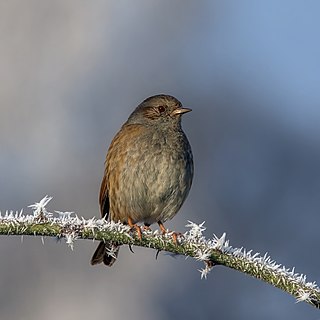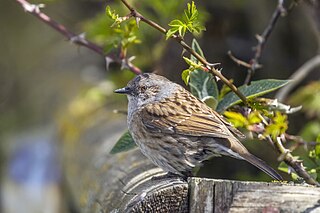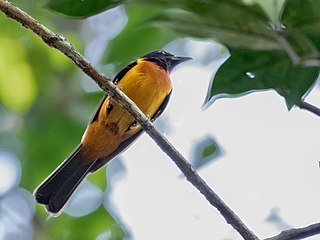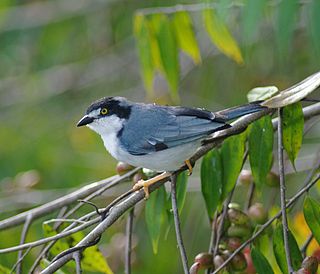
The accentors are a genus of birds in the family Prunellidae, which is endemic to the Old World. This small group of closely related passerines are all in the genus Prunella. All but the dunnock and the Japanese accentor are inhabitants of the mountainous regions of Europe and Asia; these two also occur in lowland areas, as does the Siberian accentor in the far north of Siberia. These birds are not strongly migratory, but they will leave the coldest parts of their range in winter and make altitudinal movements.

The ioras are a small family, Aegithinidae, of four passerine bird species found in south and southeast Asia. The family is composed of a single genus, Aegithina. They were formerly grouped with the leafbirds and fairy-bluebirds, in the family Irenidae.

The avian genus Quiscalus contains seven of the 11 species of grackles, gregarious passerine birds in the icterid family. They are native to North and South America.

The dunnock is a small passerine, or perching bird, found throughout temperate Europe and into Asian Russia. Dunnocks have also been successfully introduced into New Zealand. It is by far the most widespread member of the accentor family; most other accentors are limited to mountain habitats. Other common names of the dunnock include: hedge accentor, hedge sparrow, hedge warbler, and titling.

The alpine accentor is a small passerine bird in the family Prunellidae, which is native to Eurasia and North Africa.

The great antshrike is a passerine bird in the antbird family, Thamnophilidae. It is the only member of the genus Taraba. It is a resident breeder in the tropical New World in southern Mexico, Central America, Trinidad and South America down to northern Argentina and southeastern Brazil.

The black-faced waxbill is a common species of estrildid finch found in southern Africa. It is found in Angola, Botswana, Kenya, Namibia, Rwanda, South Africa, Tanzania, Uganda, Zambia and Zimbabwe. The IUCN has classified the species as being of least concern.

Lanio is the genus of shrike-tanagers in the family Thraupidae.

The thick-billed green pigeon is a species of bird in the family Columbidae.

The São Tomé green pigeon is a species of bird in the family Columbidae. It is endemic to the island of São Tomé in São Tomé and Príncipe. Its natural habitat is subtropical or tropical moist lowland forests. The species was described by Johann Friedrich Gmelin in 1789. They have disappeared from Ilhéu das Rolas due to habitat loss. There are around 10,000 pigeons of this species today.

The giant antshrike is a species of bird in the family Thamnophilidae, belonging to the monotypic genus Batara. It is found in the southern Yungas, western Paraguay and the southern Atlantic Forest. This is the largest species of antbird, measuring 34 cm long and weighing around 150 g.

The crow-billed drongo is a species of bird in the family Dicruridae. It is native to moist tropical forests of southeastern Asia where its range extends from India to the Philippines and Indonesia. It is a completely black bird with a shallowly forked tail and is similar in appearance to the black drongo. It breeds between April and June, the cup-shaped nest being built in the fork of a branch by both birds, the female afterwards incubating the eggs. It is a common bird and the IUCN has listed it as "least concern".

The variegated antpitta is a species of bird in the family Grallariidae. It is found in southeastern Brazil, eastern Paraguay, the Guianas and the northern Amazon Basin. Its range extends to Venezuela in the northwest; in the Amazon Basin, it is found in the downstream half of the basin, as well as in the Atlantic outlet region of the neighboring Tocantins-Araguaia River drainage to the southeast. A minor disjunct population is in Peru, and an Argentinian population is found in the tongue of land between Paraguay and southern Brazil.

The spot-backed antshrike is a species of bird in the family Thamnophilidae. It is the only member of the genus Hypoedaleus. It is found in southeastern Brazil, eastern Paraguay and far northeastern Argentina. Its natural habitat is subtropical or tropical moist lowland forest.

The fulvous shrike-tanager is a South American bird in the tanager family Thraupidae. It is found in Brazil, Colombia, Ecuador, French Guiana, Guyana, Peru, Suriname, and Venezuela. Its natural habitat is subtropical or tropical moist lowland forests.

The hooded tanager is a species of bird in the tanager family Thraupidae. It is found in Argentina, Bolivia, Brazil, Colombia, French Guiana, Guyana, Paraguay, Peru, and Venezuela. Its natural habitats are subtropical or tropical moist lowland forest, subtropical or tropical mangrove forest, and heavily degraded former forest.

Radde's accentor is a species of bird in the family Prunellidae. It is found in mountainous parts of Yemen and northern Southwest Asia.

The robin accentor is a species of bird in the family Prunellidae. It is found in the mountainous regions of Afghanistan, Pakistan, India, Nepal, Bhutan and China, at altitudes between about 3,000 and 5,500 m. It is a brown bird with a grey head and an orange-red breast. It is common in parts of its range and its conservation status has been assessed by the International Union for Conservation of Nature as being of "least concern".

The rufous-breasted accentor is passerine bird in the family Prunellidae, endemic to the Himalayas, descending in the winter to lower-to-middle altitudes. It is found in Afghanistan, Bhutan, Tibet, China, India, Myanmar, Nepal, and Pakistan.

The hook-billed vanga is a species of bird in the family Vangidae. It is endemic to Madagascar. Its natural habitats are subtropical or tropical dry forest, subtropical or tropical moist lowland forest, and subtropical or tropical moist montane forest.


























